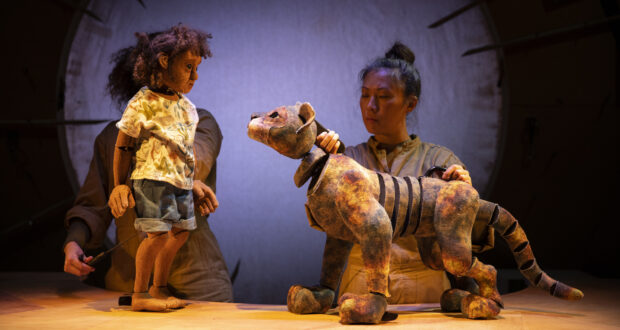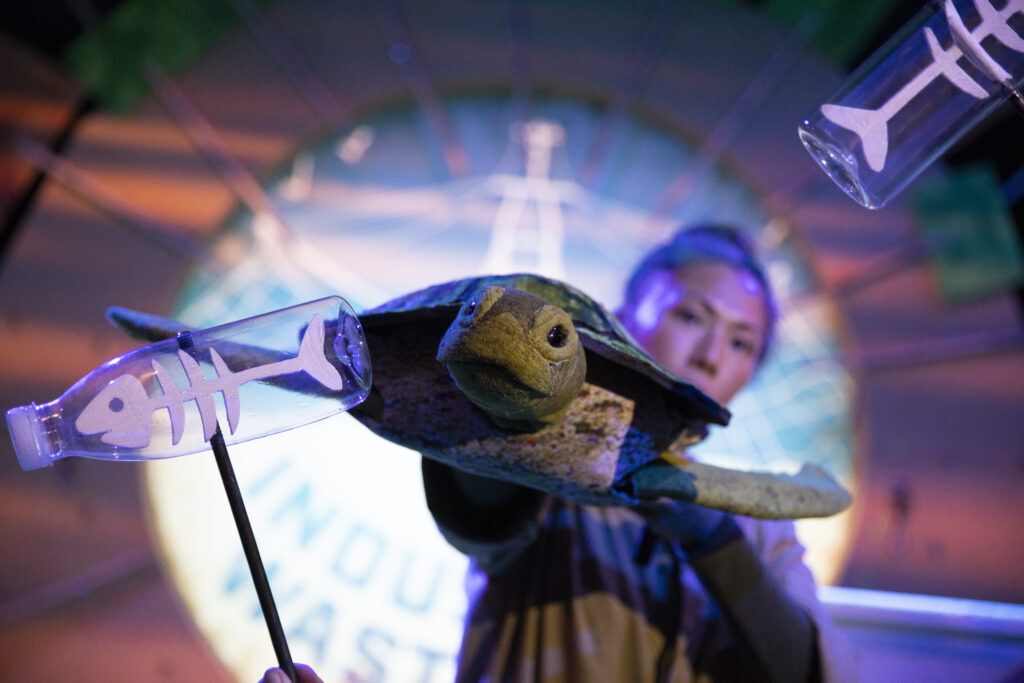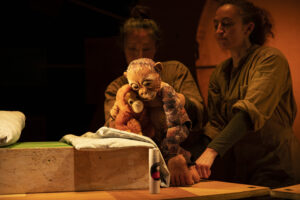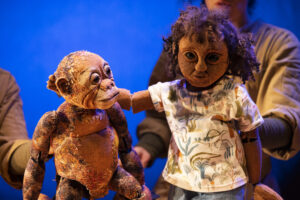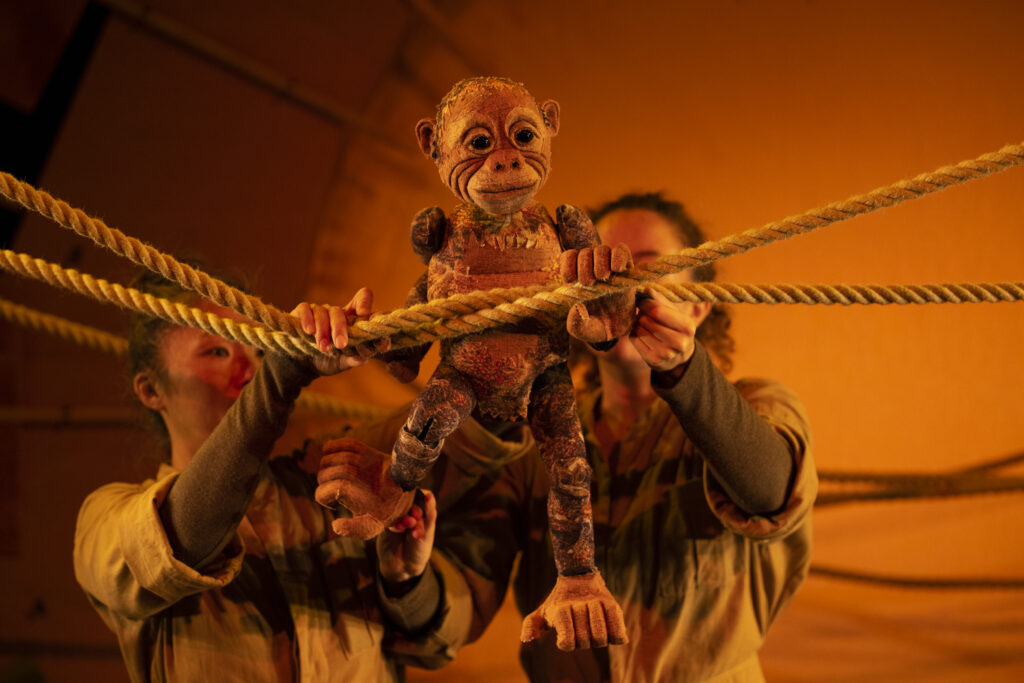There’s a Rang-Tan in my Bedroom at The Little Angel Theatre recently got a whopping five stars from us. It’s a puppet show for children from ages 5-11 that challenges human environmental damage by showing how it affects some of the animals impacted by businesses such as dirty palm oil production, and by plastic waste in the ocean. Heavy stuff for our little ones to handle, perhaps? But they all seemed to have great fun in the process and came out buzzing! We asked director and puppet maker Maia Kirkman-Richards to tell us a bit more about the show.
So Maia, this might seem quite a challenging topic for children, but you’ve approached it very directly, simplifying rather than dumbing down. What’s been the response?
It’s been incredibly exciting for me to work on this project, especially as it’s a show that genuinely encourages conversation from its audiences – something that I’ve really missed over the last couple of years.
The show itself is based on two really beautiful adverts that Greenpeace created a few years ago, so to try and shy away from any of the discussion that they held just felt wrong, regardless of the age of our audience. Having said that, ultimately our aim has always been to leave audiences feeling empowered and excited about the prospect of change and all the new opportunities that may bring – and I really feel like that excitement and eagerness for change has been largely reflected in the response to the show from the audience and reviewers.
It felt really important that we placed our audience at the heart of this story and allowed their voices to be heard. A beautiful result of that is that we are constantly engaging and hearing responses about the show, it’s subject matter and what we can do to make a difference. I love hearing about the things that our young audience members passionately shout out – at this moment in time it feels like it’s the most authentic and heart-warming response that a director could hope for.
The Rang-Tan story is probably well known to many people from the Iceland Christmas ad a few years ago, and is also a picture book by James Sellick. How do you think puppetry works differently to other media in telling this story?
Puppets are brilliant for allowing an audience to really invest a part of themselves within the characters and the story. As a puppet designer, you are never looking to create 100% of the puppet, it’s really important to allow that neutral space for the audience to see and add an element of themselves in, that way they become invested and so when something happens to the puppet, the audience feel it too. That emotional connection that an audience develops with a puppet is incredibly useful and important to our storytelling and kept every audience member as one of the show’s key protagonists.
However, it was quite daunting when approaching this project to figure out how to transfer such an iconic series of adverts into something that would work physically on stage. The main question we needed to answer was how do we recreate so many different locations without it feeling like a slightly wasteful amount of set and props that would only get used once. That would be pretty hypocritical of us right?! It was a joy to problem solve this with the creative team though and ultimately I’m proud of our choices.
The puppets in the play are absolutely beautiful, and so creatively used. Can you tell us about how you devised them?
This was actually a really tricky one, and I definitely spent a lot of days and nights exploring different options!
As a production we wanted to push to create a show that was more environmentally aware in its creation and this was a real challenge for me. In the process of creating these puppets, I discovered some incredible recycling centres across South London and really enjoyed having to think outside the box and wherever possible, use what was available to me.
As for the visuals of the puppets, I wanted to create characters that although inspired from the animals in the adverts, they felt like they had their own identity and language. It has been such a privilege to have the time to learn more about these animal’s habitats and the serious threats that they are up against, and I wanted to pay homage to that. Each of the animal puppets in the show are covered in a bespoke fabric, made up of images of either their habitats, or the objects that threaten them. Our Jaguar is entirely covered in ariel photos of the Amazon Rainforest burning, our turtle is covered in photos of plastic floating in the ocean and piling up on beaches, and our orangutan is covered in photos of palm fruits. My aim with these puppets is always to ensure that you see the puppet and the animal first – the visual stories behind their fabrics is something that you have to search for as an active audience – I think that’s really exciting.
I loved how the audience and the animals become part of an actively shared world through the staging. Was this a conscious choice, or did it just evolve in the production process?
Yes! I have always been a big fan of creating work that feels genuinely accessible to lots of different types of audience. For me, that means ensuring that people have different options of how to ‘watch’ a show – giving them plenty to look at as well as listen to, interact with and be a part of. So it was definitely a conscious choice to involve the audience in as much as we could and place them right in the heart of the story, experiencing it alongside our puppet characters as it all unfolds.
Our Set Designer, Kate Bunce, created a really special set for this show and I loved all our early conversations about how to create something on a small scale that somehow still felt vast and all consuming. Kate was so responsive to the show that we were creating (things were still changing in the final days of rehearsal!) but that meant that we could constantly push ourselves towards the most exciting visual options without limitations of what it had to look like. Being truely responsive and adapting as you go is a real gift and not something that everyone can do, so I really lucked out with my creative team in that sense.
There are so many details in the show that signal problem items in the home, and the urgency of the situation. It’s almost like a ‘Where’s Wally?’ once you start to spot them. Did this help in constructing multiple layers of engagement for different age groups?
Yes absolutely, I think that a lot of the time the layers built up quite naturally as myself and the team learnt more and more throughout the rehearsal process!
As with a lot of work for children, you end up with such a wide age range of people in your audience (from babies to grandparents and everyone in between) so I was mindful to make sure that there was something for everyone. So the ‘signals’ that you mentioned could be spotted not only in the puppets and props, but also in the set, the projection, the lighting colours, the speech and of the course the soundtrack.
Another thing I loved about the show was that the children were handed an opportunity to voice their opinions and get creative with solutions. Have you had any follow-up responses from your audiences?
I love that about the show too – it’s such a joy to hear the ideas that the audience passionately shout out in each performance. I had an email come through just today to say that one young audience member had shouted out “Go in a boat and collect all the plastic bags from the sea!”. It’s so important that our audiences feel like their voices are heard and that without them, change cannot actually happen.
I know that The Little Angel has had some lovely feedback emails from families after the show, chatting about how the show has impacted life beyond the theatre walls. I read one that simply said ‘My son now says he’ll eat less snacks in plastic bags!’ – I think her son is a legend.
What’s next for Rang-Tan and her friends?
Good question! We’re really hopeful that this is the start of the theatre industry opening back up and thriving again so that we can continue to share this production with new audiences around the country – starting with a National tour in autumn 2022.
There’s A Rang-Tan in my Bedroom and Other Stories runs at Little Angel Theatre until 7 November. Further information on this and other shows can be found via the below link.
 Everything Theatre Reviews, interviews and news for theatre lovers, London and beyond
Everything Theatre Reviews, interviews and news for theatre lovers, London and beyond
